ISUR Poster Expo Showcases Engineering Scholars' Research
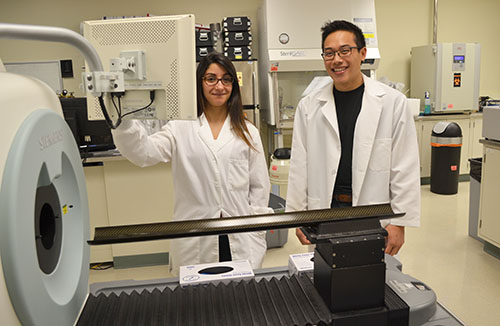 ISUR scholar Than Huynh (right), and his grad student mentor, Jamila Hedhli.
ISUR scholar Than Huynh (right), and his grad student mentor, Jamila Hedhli.
April 26, 2018
On Wednesday, April 18th, 26 engineering students who have been participating in the Illinois Scholars Undergraduate Research (ISUR) program had a chance to present about the research they’ve been conducting during the 2017–2018 academic year. For the scholars, the opportunity to do research in the lab of one of Illinois' world-class researchers not only exposed them to what research is like, but gave them a window into whether research itself, or even the topic they'd been studying over the last year, might be a part of their career plans down the road. Still others discovered that they couldn't see themselves doing research long-term.
ISUR provides scholarships for students addressing research related to the interests of the following sponsors who fund the program: the Semiconductor Research Corporation; Intel, Shell, Dow, John Deere, and Rockwell Collins. Research areas the sponsoring corporations were focusing on in 2017-2018 included: semiconductors, electronics, information technology, energy and the environment, chemical solutions, agricultural biotechnology, and health.
In 2017–2018, ISUR provided scholarships for 36 participants who conducted research in one of the above areas for two semesters. Of those, 26 presented in this year’s Poster Expo (ten graduated back in December). To find out more about the ISUR program itself, including how students are selected and additional benefits of this research opportunity, see this companion article.
Patrick Burke
What were some of the benefits students reported that they had gained from the research experience? According to Patrick Burke, a MechSE junior who has been working in MechSE Professor Sung Woo Nam’s lab since the beginning of his sophomore year, it accelerated the learning process.
"I thought it was a great experience. I learned a lot,” Burke says regarding being involved in research, then mentions a couple of specific areas in which he grew as a result of the research:
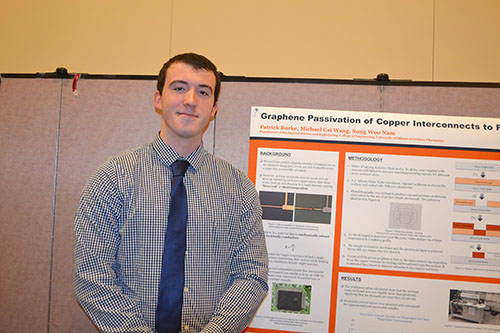 Patrick Burke with his poster at the 2018 ISUR Poster Expo.
Patrick Burke with his poster at the 2018 ISUR Poster Expo.“It definitely expedites how fast I can learn compared to the classroom,” he claims. He also appreciates, “just being able to look at research articles and finally understand them now that I've had experience in this group...It's been a great experience for me.”
Regarding whether research might be in his future, Burke's plans after graduation include going into industry for a couple years, then maybe grad school after that.
One thing that drew him to Nam's lab and research was that it was nanomaterials devices and graphene, “which is a huge buzzword right now,” he explains. Another thing that appealed to him was that it wasn't purely mechanical engineering based. Because Nam’s group does a lot of graphene and material science, it allowed him to “branch out into another area but still also stay within MechSE,” Burke adds.
Nupoor Gandhi
One student who reaped the benefits of another Engineering program, MUSE (Mentoring Undergraduates in Science and Engineering), as well as ISUR was Nupoor Gandhi, a sophomore in Computer Science. She met her grad student mentor at the beginning of her freshman year as a part of MUSE, and her mentor is also supervising her ISUR research project. Funded by Intel, the project seeks to leverage social media to predict outbreaks of sexually transmitted infections.
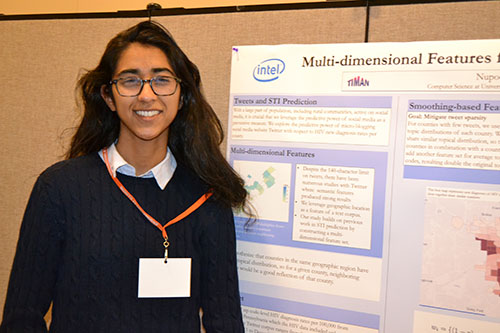 Nupoor Gandhi with her poster at the 2018 ISUR poster session.
Nupoor Gandhi with her poster at the 2018 ISUR poster session.Gandhi reports that one challenge she encountered was that communities that aren't as active on twitter didn't have a lot of data. “So we wanted to look for other ways to represent those counties that weren't purely textual,” she explains. The results of her study found that multi-dimensional features that leverage additional information were useful: “Leveraging geographic information did significantly improve our results,” she states. “It improved our baseline of just purely textual information.”
Another challenge she ran into was that social media is very dependent on population density. To correct that, she indicates that they “tried to use neighboring counties to kind of smooth the data for a given county. There are ways to work around it. But that is an important issue.”
Ghandi hopes for a career in computational public policy and plans on trying to “apply pure science to improving the way that we make public policy decisions.”
Regarding the results of her study, she says, “using social media or using the internet in general is going to be important for any career path in data science. I think this experience has definitely been very valuable for me because I was able to learn a lot about using social media with research. So I think that's important.”
Hannah Chait
One student who learned a great deal from the experience, including that long-term, developing-new-ideas kind of research wasn't necessarily for her, was Hannah Chait, a senior in Chemical Engineering. Chait was involved in research looking at the fabrication of micelles to determine how much of a biomolecule can be incorporated into polymeric micelles. These could then be incorporated into scaffolds which would be helpful in facial bone regeneration in patients.
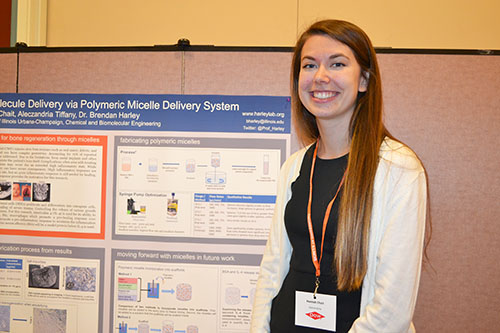 Hannah Chait with her poster at the 2018 ISUR poster session.
Hannah Chait with her poster at the 2018 ISUR poster session.Chait has been working in Professor Brendan Harley’s lab since she was a freshman. Regarding her current project, she says her graduate student, Aleczandria Tiffany, was key in helping write the proposal for the project.
Chait shares some of the things she learned through the research.
“It taught me a lot about how to think about problems,” she admits, “and how to look at the big picture of things. With research, it can be easy to kind of get lost in the nitty gritty details, like ‘I’m adding this chemical.’ So being able to do that, but also look at the big picture.”
Another thing Chait learned through the research? That this type of research isn’t really for her. She discovered that she likes “being closer to the end goal,” she explains. “This research was kind of focused on developing new ideas, which take a longer time to reach people and start impacting their lives. So I prefer research that’s a little bit closer to the people.”
Despite this discovery, she reports that her year of research had been a “really good experience, just seeing what I like, and what I don’t like, and what areas of research I might be interested in in the future.”
Amber Boyce
Like Chait, Amber Boyce, also discovered that would prefer short-term research projects. Another senior in ChemE, who also works in Professor Brendan Harley’s lab, she began doing research there her sophomore year. After she graduates, she’s working for Clorox Corporation doing research on consumer products.
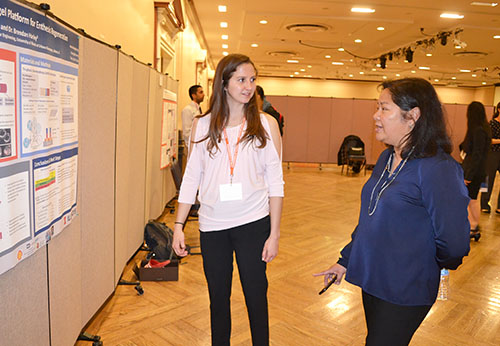 Amber Boyce explains her poster to Coordinator of Engineering's Undergrad Research Office, Tasha Mamaril.
Amber Boyce explains her poster to Coordinator of Engineering's Undergrad Research Office, Tasha Mamaril.According to Boyce, one of the biggest challenges she faced during her research was working with cells. “We seeded cells into our scaffolding,” she reports, “and the cells are really finicky; if you use expired components to make the media that feeds them, they just die. If ethanol gets spread into the container, they die. So I think that’s maybe the most challenging, because then you have to spend a week or two growing them old enough to use again. So you could be set back several weeks just if you make a little mistake.”
So one thing she learned was: “There’s a lot of sterile techniques to not kill the cells,” she reports.
Boyce indicates that while her ISUR research was more long-term and might not be applicable for decades, the research she’ll be doing at Clorox will be more short-term, such as two-year projects, where she’ll be “trying to improve the products that they have in order to solve consumer frustrations.”
So the next bottle of Clorox that you buy, if you notice that it smells better, you might have Boyce to thank!
Rachel Tham
Rachel Tham, a sophomore in Agricultural and Biological Engineering, did a project testing the number of times the salt in a sun bucket could be heated and cooled to determine at what temperature the salt might not be as efficient. Tham has been involved with research since the first semester of her freshman year.
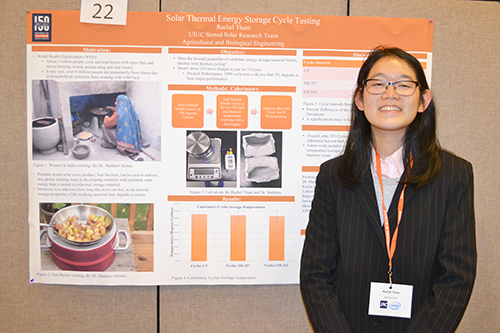 Rachel Tham with her poster at the 2018 ISUR poster session.
Rachel Tham with her poster at the 2018 ISUR poster session. Remarking that she’s a “big picture/concept” person, Tham indicates that “Being able to work with the salt, especially the materials science part of it," really attracted her to the project. In addition, she was also drawn to improving the performance of the product, because it was both ecologically friendly and uses sustainable energy. She says she was excited about “the potential of sun buckets in not only helping to decrease the pollution of cooking with wood, but also being able to empower women in developing countries who need this kind of product in cooking sustainably.”
Another reason the project appealed to her is because she’s interested in a career in energy storage and renewable energy, “And this project is related to that,” she says.
What are some things she’s learned doing research? “When you’re in class, you’re learning a lot of theory and equations…I felt that a lot of it wasn’t really applied towards my research, in that even simple equations can be complicated in real life.”
She also learned, “You don’t need fancy tools to do valuable research, and realizing that you can apply anything around you and question about it is also really valuable.”
Elizabeth Woodburn
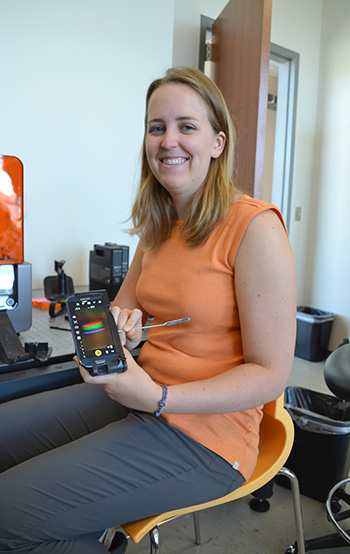 Elizabeth Woodburn exhibits the smartphone bio-sensor platform she helped to develop in Professor Brian Cunningham's lab.
Elizabeth Woodburn exhibits the smartphone bio-sensor platform she helped to develop in Professor Brian Cunningham's lab. One student who thinks research is definitely in the picture down the road is Elizabeth Woodburn, a senior in Bioengineering, who has been doing the same research project in Professor Brian Cunningham’s lab during her entire career at Illinois. Her research? A smart phone bio-sensor platform for affordable mobile detection of different diseases and conditions.
Woodburn explains how she got involved in the lab. After perusing the BioE website, she sent an email to Cunningham, whose research looked interesting to her, asking if he was looking for an undergrad. She reports: “I got lucky on the first try!” She adds that she was paired up with a really great mentor, wrote a proposal, and has been part of ISUR since the second semester of her freshman year.
Regarding working on the same project for the last four years, she reports, “It’s been really neat to see the continuity of it; I’ve worked on little bits of a lot of different parts of it, so I’ve seen it come together.” Equally rewarding was the fact that she’s listed on a publication featuring the work.
Woodburn is headed to the Carle Illinois College of Medicine this summer, and plans on doing an MD/PHD.
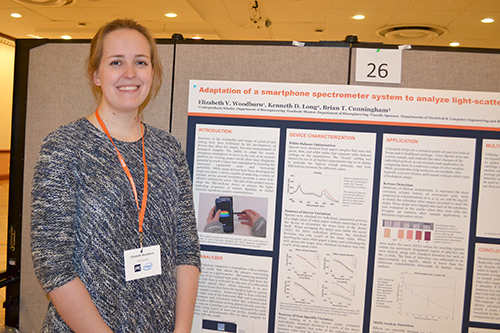 Elizabeth Woodburn with her poster at the 2018 ISUR poster session.
Elizabeth Woodburn with her poster at the 2018 ISUR poster session. It’ll be interesting,” she acknowledges. “It’s the first engineering-based college of medicine, and I’m excited because it’ll be very case-learning based with lots of hands-on applications.”
What skills has she gained? “I think the longitudinal exposure to the same project has been really cool, starting with more basic skills, then slowly got to move into designing experiments, executing them." She adds that having the same graduate student for three years has been "really, really wonderful, because he's been able to facilitate that growth. And now I'm at the point where I'm checking with him once a week and running my own experiments."
Nicole Jugovich
Nicole Jugovich, a sophomore in Chemical Engineering, claims her ISUR experience, which was her first time doing research, “Very exciting!”
Her research project consisted of controlling and optimizing a simple drop-casting method for producing single crystals. Important because they’re best for conductivity, these crystals could eventually be used in organic electronic devices.
She shares why she got involved with ISUR. “Basically, I was always interested in further developing my lab techniques and just seeing what it’s like to research and if I would be interested in doing that as a career. I feel like the only way to find out is to try it. And I like challenging myself to grow.”
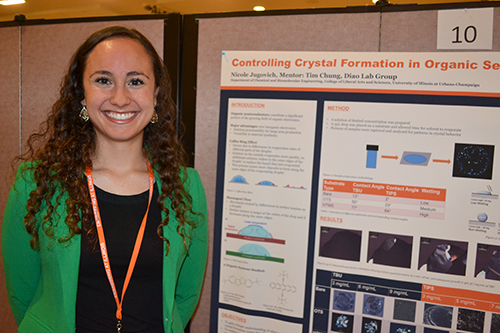 Nicole Jugovich with her poster at the 2018 ISUR poster session.
Nicole Jugovich with her poster at the 2018 ISUR poster session. What did she think? “I really liked it! I’m looking to continue researching next year as well.”
While her current grad student mentor is graduating, she’s choosing to see the silver lining: “I’m excited in a way about that, because it allows me to learn about somebody else’s project and explore different realms of research. I’m optimistic about just trying something new!”
Jugovich reports that one of the benefits of her experience was honing her lab techniques: “I was very clumsy with using tweezers, for example,” she admits. “When I first starting using them, my grad student was like, ‘Um, I see you don’t have much experience using tweezers. You’re holding them like you hold chopsticks or something.’” But Jugovich reports that, “Yes, I can do that much better now!” She reports that she’s also much better at using the microscope, and that she understands how it works.
She indicates that she also learned a lot about problem solving and troubleshooting. For example, she detected that she and her lab mates were using a bad batch of molecules. She noticed that it was “more powdery” than a previous batch, wondered about it, and they ended up discovering that it was a bad batch and had to throw out a test. “That whole thing was a learning experience,” she reports. “But it was kind of a frustrating time, because we were trying to figure out what we were doing wrong.” But she recalls that it was a “good lesson in perseverance and trying to troubleshoot.”
Regarding her career plans, Jugovich’s career goal is to start her own line of more natural and affordable makeup. But she believes her research experience will better prepare her:
“I think that having experience, having done research will be valuable to me. In order to best achieve her goals, she believes it’s important to understand what everyone who works for her will be doing: “So that’s what I think is so special about having done research; it’s going to allow me a lot of different perspectives.”
Story and photographs by Elizabeth Innes, Communications Specialist, I-STEM Education Initiative.
More: Engineering, Undergrad, Undergrad Research Symposium, 2018
FFor more I-STEM articles about Engineering undergraduate research, see:
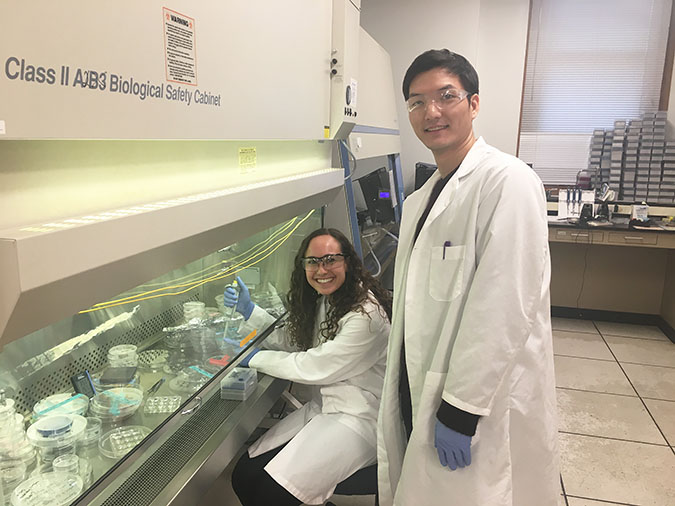 ISUR scholar Nicole Juguvich and her grad student mentor, Hyunjoong (Tim) Chung, at work in Chemical Engineering Professor Ying Diao's Lab (photo courtesy of Nicole Juguvich).
ISUR scholar Nicole Juguvich and her grad student mentor, Hyunjoong (Tim) Chung, at work in Chemical Engineering Professor Ying Diao's Lab (photo courtesy of Nicole Juguvich). 












.jpg)
















